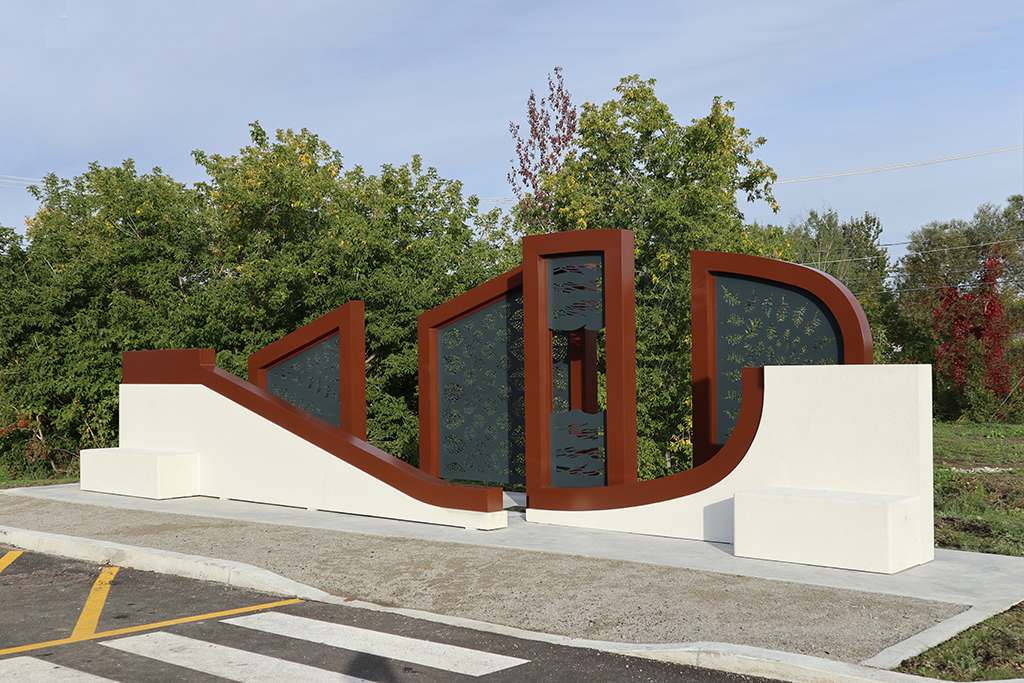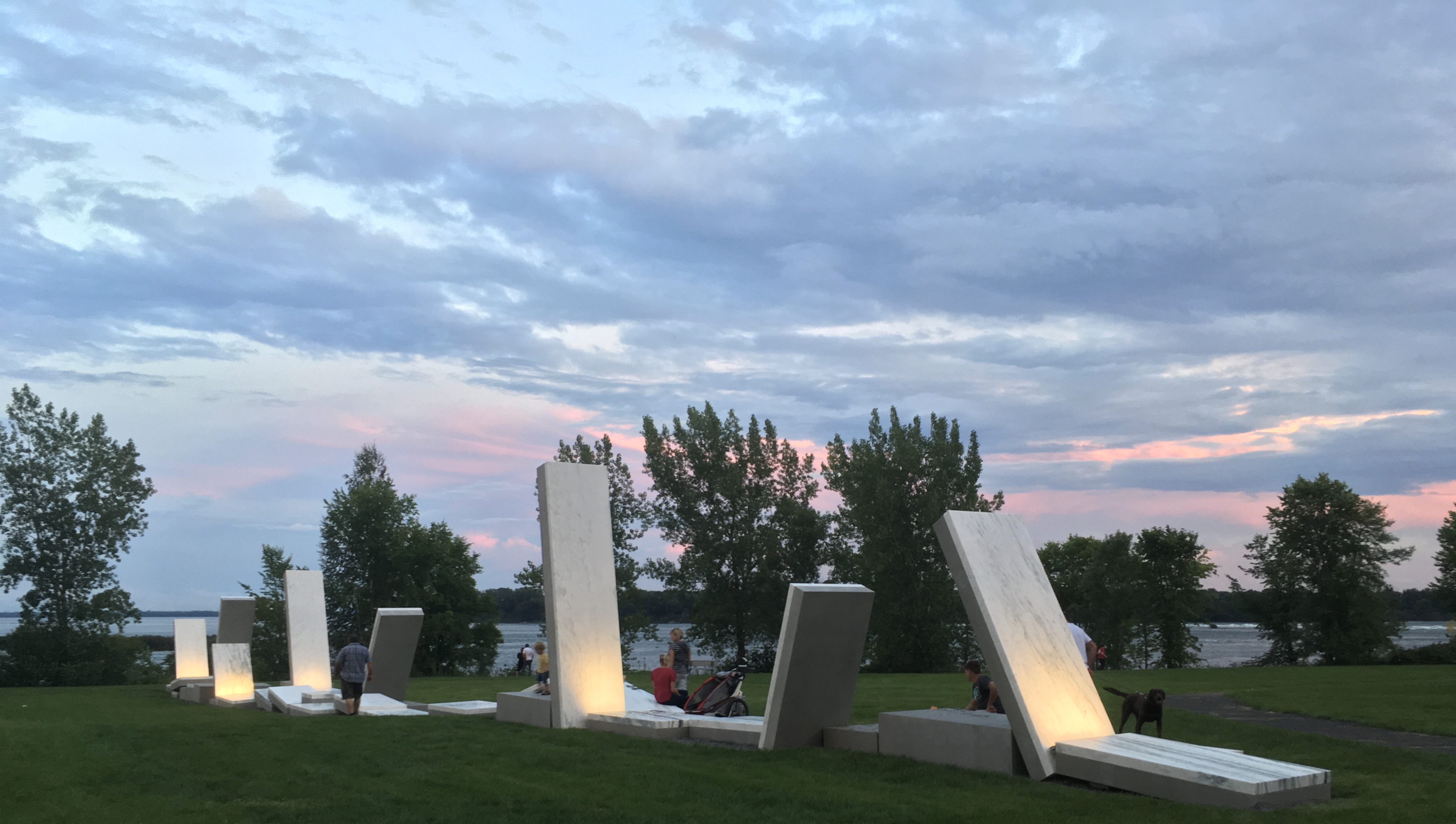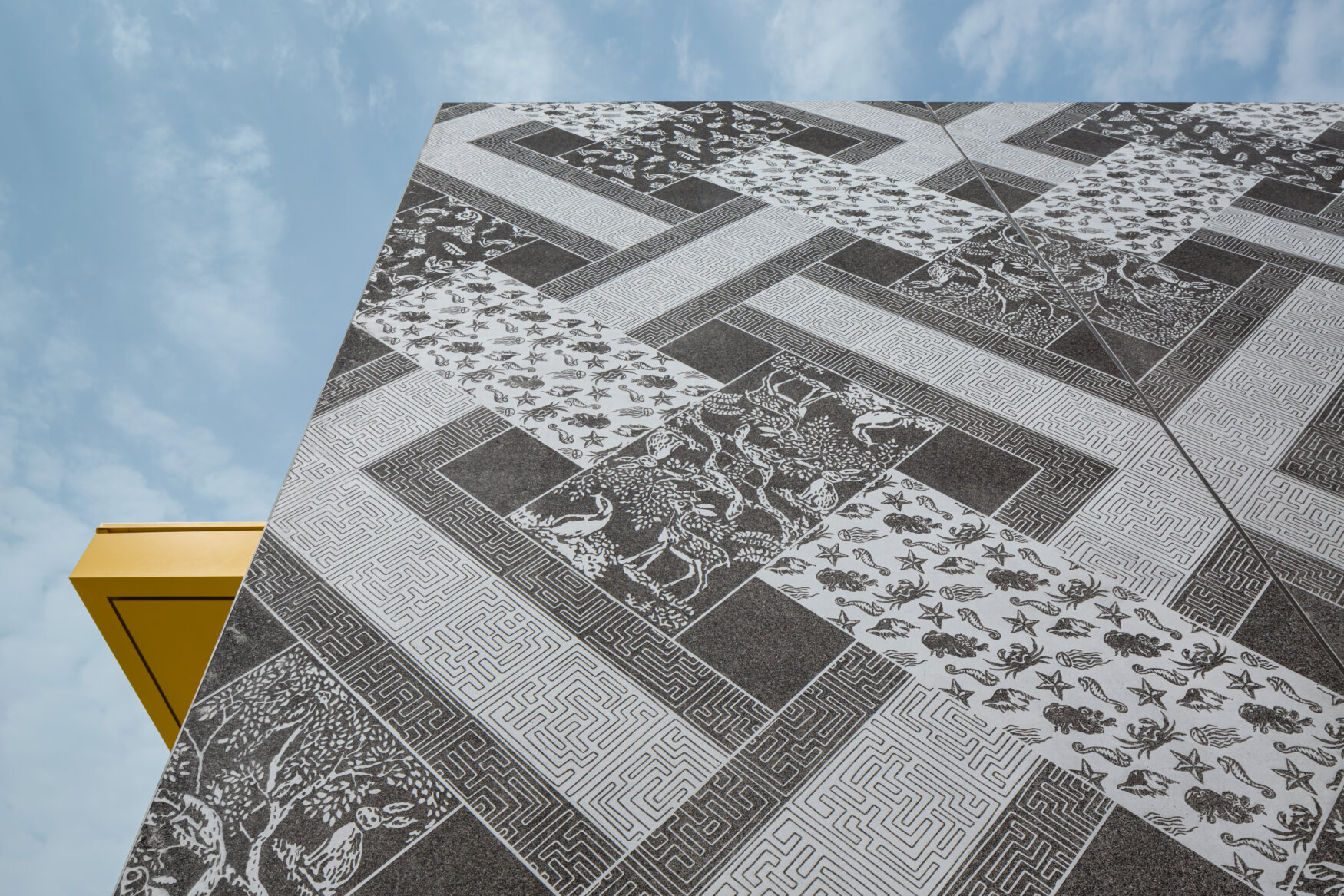Par Isabelle Simard
Heureuse combinaison de créativité et d’innovation, l’art public incite l’industrie du béton préfabriqué à exploiter la grande plasticité du matériau. L’intégration d’œuvres d’art à l’architecture et à l’environnement enrichit l’espace urbain et permet aux designers d’offrir une signature visuelle unique à leurs projets. Pour BPDL, mettre le béton au service de l’art est une excellente occasion de démontrer la souplesse du matériau et sa grande versatilité.
L’art public s’intègre harmonieusement à des lieux qui ne sont pas consacrés à la présentation d’œuvres d’art tels que des écoles primaires et secondaires, des cégeps, des universités, des hôpitaux, des bibliothèques, des salles de spectacles, des musées, des centres d’exposition, des édifices publics et privés, des haltes routières et des parcs. Le béton préfabriqué occupe une place de choix parmi les matériaux utilisés pour concevoir des œuvres dans ces espaces publics.
BPDL a mis son expertise au service de l’art à plusieurs reprises au fil des années en accompagnant des artistes dans la réalisation de projets tous plus originaux les uns que les autres. Parallèlement, BPDL a fait appel à des artistes pour certains projets de restauration de bâtiments historiques nécessitant une connaissance approfondie des techniques utilisées lors de leur conception à différentes époques. Citons notamment la restauration de Gasson Hall et St-Mary’s Hall.
Dans cet article, nous vous présentons quelques-uns des projets réalisés par BPDL dans le domaine de l’art public.



« Le béton est un matériau de base en art public. Pour ce projet, j’avais besoin d’une masse opaque et solide. Les éléments de béton préfabriqué ont été conçus avec une précision exceptionnelle, épousant parfaitement les pièces d’aluminium », explique Camille Rajotte.
Le béton blanc est à l’honneur dans cette œuvre d’art public permanente intitulée À TRAVERS LES BOIS. L’œuvre, que l’on peut admirer à l’Hôpital Ville-Marie dans la région de l’Abitibi-Témiscamingue, est composée de différents éléments qui s’assemblent pour créer l’image d’une raquette sur la neige.
Cette perspective ingénieuse permet au spectateur d’apprécier l’œuvre de façon différente selon son positionnement. De l’intérieur du bâtiment, les usagers de l’hôpital peuvent la contempler dans son ensemble et y voir l’image de la raquette. À l’extérieur, ils peuvent s’asseoir ou se promener à travers les éléments pour apprécier quatre tableaux. Ces tableaux sont composés de motifs organiques référant à des particularités naturelles de la région, tels que les feuilles de bouleau, les vagues et les branches de cèdre.


« Le béton est un matériau que j’ai toujours privilégié. Dans ce cas-ci, on marche sur la structure, alors il fallait que ce soit solide », précise l’artiste Jacques Bilodeau dans une entrevue réalisée à savoir.media.
À Montréal, dans l’arrondissement Lasalle, l’œuvre artistique de Jacques Bilodeau suscite l’émerveillement au Parc des Rapides. L’œuvre, qui a été conçue en tandem avec la firme CCxA, est une sculpture-paysage composée d’une quarantaine d’éléments séquentiels, juxtaposés ou inclinés, en marbre blanc et en béton.
Le béton a été utilisé pour sa solidité, mais aussi pour créer un bel amalgame avec le marbre. Le parcours linéaire d’une longueur de 47 mètres invite les visiteurs à s’y asseoir, l’escalader ou s’y reposer. AU GRAND DAM est une œuvre lumineuse qui rappelle la présence d’un ancien barrage et des rapides à proximité.



Le béton préfabriqué est utilisé de façon inusitée dans cette œuvre de Patrick Bernatchez baptisée 29-53 en référence à la durée moyenne entre deux nouvelles lunes, soit 29,53 jours. Installée au nouveau Campus MIL de l’Université de Montréal, la structure est d’une hauteur de près de 20 mètres et d’une largeur de cinq mètres. Elle comporte deux murs de béton coulé en place sur lesquels repose une structure imposante à deux faces en béton préfabriqué. Une reproduction de la face cachée de la lune est présentée sur l’une des faces et la seconde a été conçue comme paroi d’escalade.
Les panneaux de béton préfabriqué sont fixés à une structure complexe en acier, le tout reposant sur des murs en béton architectural. Les formes de béton qui représentent la partie de la surface de la lune ont nécessité la fabrication de moules d’une grande complexité. Des matrices de coffrage (formliners) ont été utilisées pour reproduire les formes dans leurs plus petits détails.
Cette vidéo de Patrick Bernatchez illustre en images et en musique l’histoire de cette œuvre magistrale d’art public.



La technique novatrice de membrane et photogravure a été utilisée par BPDL pour créer cette œuvre d’art public permanente commandée parla Commission scolaire de Montréal pour l’École primaire Saint-François-d’Assise.
L’artiste Shelly Miller signe son œuvre LANGUETTES ET LABYRINTHES sur trois grands murs extérieurs de l’école. Les languettes, constituées de larges bandes diagonales entrelacées aux couleurs gris clair et sombre, créent l’effet d’un tissage. Le contraste entre la texture lisse du gris pâle et celle granuleuse du gris foncé, a été obtenue en utilisant différents agrégats dans le béton. L’artiste y présente des labyrinthes et des motifs naturalistes illustrant une faune terrestre et aquatique.


Située entre les pavillons Charles-De Koninck et Jean-Charles-Bonenfant, l’œuvre intitulée 2367 L’ODYSSÉE COLLECTIVE commémore l’apport des donateurs à la septième grande campagne de financement de l’Université Laval. Ce monolithe a été conçu par cinq diplômés en architecture de l’Université Laval (collectif PLUX.5). L’œuvre se compose de béton blanc. Le recouvrement intérieur est constitué de fines couches de feuilles d’or 23 K.
Symboliquement, cette œuvre contient en son centre une capsule temporelle à l’intérieur de laquelle reposent les documents colligés des membres Les Cent-Associés qui décrivent ce qui anime leur geste philanthropique. Cette capsule a été conçue pour être ouverte dans 350 ans, soit en 2367.


« Avec BPDL, c’est une collaboration, mais c’est aussi un travail qui se fait dans un esprit de grande confiance (...) Le béton pour moi, c’est toute ma carrière d’artiste. Et quand on parle de cela, j’ai même l’odeur qui me vient au nez », dit-elle, dans l’entrevue Les Bâtisseurs Cogeco 2017.
L’artiste Claire Maltais a réalisé de nombreux projets en collaboration avec BPDL. Son œuvre CITÉ-RIVIÈRES est composée de 40 bas-reliefs illustrant la vie aux abords des affluents du Lac-Saint-Jean. On peut la contempler sur les berges de la rivière Petite-Décharge, sur les paliers de la promenade urbaine. Le nom des nombreux cours d’eau qui y passent est également gravé sur les garde-corps de béton de la promenade.


Le béton armé coloré a été utilisé pour la conception de ces deux monuments religieux signés par l’artiste Jean-Marie Laberge : L’ANGE ET L’ENFANT, situé au Cimetière Saint-François-Xavier et SŒUR FRANÇOISE SIMARD, situé devant l’ancienne maison d’enseignement de la communauté des sœurs du Bon-Conseil, à Chicoutimi. Jean-Marie Laberge a réalisé plusieurs projets en collaboration avec BPDL, ce dernier concevant lui-même les moules, pour ensuite les apporter en usine et assister à la coulée du béton.
« L’art public façonne la beauté du Québec et forge son identité. En animant les parcs, places et édifices, il réinvente des lieux accessibles à tous. » - Ville de Québec
« C’est l’art qui accompagne notre quotidien au fil des rues. Il s’agit des œuvres installées dans les espaces urbains, tels que les places publiques, les parcs, ou les œuvres intégrées aux édifices et qui sont accessibles aux citoyens. » - Ville de Montréal
« La politique d’art public de la Ville de Saguenay, c’est de constituer une collection d’œuvres d’art à l’image du dynamisme artistique et culturel de la Ville. » - Ville de Saguenay
« L’art public est une invitation à explorer un patrimoine artistique et culturel, de même qu’à porter un regard autre sur l’art qui nous entoure au quotidien dans nos espaces urbains. » - Ville de Longueuil
Au Québec, la Politique d’intégration des arts à l’architecture et à l’environnement des bâtiments et des sites gouvernementaux et publics exige que tout projet de construction, d’agrandissement ou de réaménagement obtenant une subvention gouvernementale pour sa réalisation et dont le coût est de 150 000 $ ou plus, doit réserver environ 1% de son coût total à l’intégration d’une œuvre d’art.
By Isabelle Simard
Public art, as a positive combination of creativity and innovation, encourages the precast concrete industry to harness the high plasticity of the material. The integration of works of art into architecture and the environment enriches urban space and allows designers to share their projects with a visually unique signature. For BPDL, using concrete in the service of art is a great opportunity to demonstrate the flexibility of the material and its great versatility.
Public art blends harmoniously into places that are not typically devoted to presentation of works of art, such as primary and secondary schools, general and professional teaching colleges, universities, hospitals, libraries, performance halls, museums, exhibition centers, public and private buildings, rest areas and parks. Precast concrete plays a major role in the materials used for designs in these public spaces.
Over the years, BPDL has often used its expertise in the service of art by supporting artists in the realization of projects, each one more original than the next. At the same time, BPDL has collaborated with artists on certain historic building restoration projects requiring in-depth knowledge of the techniques used in their design. Of particular note is the restoration of Gasson Hall and St. Mary’s Hall.
In this article, we will present some of the public art projects carried out by BPDL.



"Concrete is a basic material in public art. For this project I needed an opaque and solid mass. Precast concrete elements have been designed with exceptional precision, fitting perfectly with aluminum parts," explains Camille Rajotte.
White concrete has a place of honor in this permanent public art work titled À TRAVERS LES BOIS. The work, which can be explored at the Ville-Marie Hospital in the Abitibi-Temiscamingue region, is made up of different elements that come together to create the image of a snowshoe on snow.
This ingenious perspective allows the viewer to appreciate the work in different ways depending on their position. From inside the building, hospital users can contemplate it as a whole and see in it the image of the snowshoe. Outside, they can sit or wander through the elements to enjoy four scenes. These scenes are composed of organic designs based on the natural features of the area, such as birch leaves, waves and cedar branches.


"Concrete is a material that I have always favored. In this case, the structure can be walked upon, so it has to be solid," says artist Jacques Bilodeau in an interview with savoir.media.
In the Lasalle borough of Montreal, the art work of Jacques Bilodeau inspires wonder at Parc des Rapides. The piece, which was designed in tandem with the firm CCxA, is a sculpture-landscape composed of forty sequential elements, juxtaposed or inclined, in white marble and concrete.
Concrete was used for its solidity, but also to create a nice combination with the marble. The 47-meter linear route invites visitors to sit, climb or rest on it. AU GRAND DAM is a luminous work that brings to mind an old dam and near by rapids.



Precast concrete is used in an unusual way in this work by Patrick Bernatchez. It is named 29-53 in reference to the average duration between two new moons, i.e. 29-53 days. Located at the University of Montreal’s new MIL Campus, the structure is five meters wide and almost 20 meters high. It is comprised of an imposing two-sided precast concrete structure resting on two walls of cast-in-place concrete. The dark side of the moon is represented on one of the faces and the second was designed to look like a climbing wall.
The precast concrete panels are attached to a complex steel structure, all resting on architectural concrete walls. The concrete shapes that represent the surface of the moon required the manufacture of highly complex molds. Formliners were used to reproduce the shapes in their greatest detail.
This video by Patrick Bernatchez uses images and music to illustrate the history of this masterful work of public art.



BPDL used this innovative membrane and photo-etching technique to create this permanent public work of art commissioned by the Montreal School Board forSaint Francis of Assisi Elementary School.
Artist Shelly Miller signs her work LANGUETTES ET LABYRINTHES on three large exterior walls of the school. The links, made up of wide diagonal bands intertwined with light and dark gray colors, create a woven effect. The contrast between the smooth, pale gray and the grainy, dark gray textures was obtained by using different aggregates in the concrete. The artist presents labyrinths and naturalistic designs illustrating terrestrial and aquatic fauna.


Located between the Charles De Koninck and Jean Charles Bonenfant pavilions, the work entitled 2367 L’ODYSSÉE COLLECTIVE commemorates the contributions of donors to the seventh major fundraising campaign for the University of Laval. This monolith was designed by five architecture graduates from Laval University (PLUX.5 collective). The work is made of white concrete. The inner coating is made up of thin layers of 23 K gold leaf.
Symbolically, the center of this work contains a time capsule that holds documents compiled by Les Cent-Associes members describing the impetus behind their philanthropic gesture. This capsule was designed to be opened in 350 years, i.e. in 2367.


The artist Claire Maltais has collaborated with BPDL on numerous projects. Her work CITÉ-RIVIÈRES is made up of 40 bas-reliefs illustrating life on the outskirts of tributaries of Lac-Saint-Jean. It can be viewed on the banks of the Petite-Riviere emissary, on the landings of the urban promenade. The names of the many rivers which pass through it are also engraved on the concrete railings of the promenade.
"With BPDL it's a collaboration, but it's also work that is done in a spirit of great trust (...) For me, concrete represents my entire artistic career. Just by talking about it, the smell of concrete permeates my nose,” she said in the interview for Les Bâtisseurs Cogeco [Cogeco Builders] 2017.


Colored reinforced concrete was used for the design of these two religious monuments by the artist Jean-Marie Laberge : L’ANGE ET L’ENFANT, located in theSaint-Francois-Xavier cemetery and SŒUR FRANÇOISE SIMARD, located in front of the historic schoolhouse of the Sisters of Bon-Conseil community, in Chicoutimi. Jean-Marie Laberge has carried out several projects in collaboration with BPDL, designing his own molds and bringing them to the factory to watch the pouring of the concrete.
"Public art shapes the beauty of Quebec and forges its identity. By bringing parks, squares and buildings to life, it reinvents places that are accessible to all." - City of Quebec
"It is the art that accompanies our daily life on the streets. These are the works installed in urban spaces, such as public squares, parks, or works integrated into buildings, and accessible to citizens." - City of Montreal
"The City of Saguenay’s public art policy is to build a collection of works of art reflecting the artistic and cultural dynamism of the city." - City of Saguenay
"Public art is an invitation to explore an artistic and cultural heritage, like wise to take a different look at the art that surrounds us on a daily basis in our urban spaces." - City of Longueuil
In Quebec, the Policy for the Integration of the Arts into Architecture and the Environment of Government and Public Buildings and Sites requires that any construction project, expansion or redevelopment obtaining a government grant for its realization, whose cost amounts to $150,000 [Canadian dollars] or more, must reserve about 1% of its total cost for the integration of a work of art.